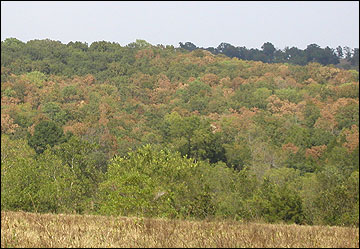Oak decline
Trees are weakened by environmental stresses such as drought, waterlogging, frost or by pests such as defoliating or sucking insects. Weakened trees are then invaded and killed by insects and diseases that cannot successfully attack healthy trees. Usually the progression of decline is slow, and it occurs over several years.
The initiating stress factors associated most frequently with oak decline are drought, frost injury or insect defoliation. Trees on ridge tops and in wet areas suffer most severely from drought. Frost often affects trees growing in valleys and frost pockets. Defoliated trees that refoliate the same season might exhibit dieback symptoms the next year. Other factors such as leaf diseases and soils that are waterlogged, compacted or shallow have occasionally been implicated in oak decline.
These stress factors often weaken trees so much that they succumb, sometimes suddenly, to the root killing and girdling actions of insects and diseases. The two major pests associated with oak decline are armillaria root rot and the two-lined chestnut borer. Periodic occurrences of decline and death of oaks over widespread areas have been recorded since 1900. These outbreaks, variously named oak decline, oak dieback or oak mortality, are caused by a complex interaction of environmental stresses and pests.

Trees affected by oak decline show a general and progressive dying back from the tips of the branches. Other symptoms include production of chlorotic, dwarfed and sparse foliage; development of sprouts on main branches and stem; and premature autumn leaf color and leaf drop. Often, growth is reduced before the appearance of symptoms. (Photo by Hank Stelzer, University of Missouri.)
-
Additional information on oak decline